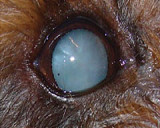Timoptol eye drops (Timolol maleate 0.5% and 0.25%)
Timolol is a beta blocker which reduces the formation of aqueous. We use Timolol BID as a prophylactic drug, especially in cases where there is prolonged irritation to Pilocarpine.
 Isoptocarpine drops (Pilocarpine 1%)
Isoptocarpine drops (Pilocarpine 1%)
Pilocarpine is a parasympathomimetic or miotic drug. Cholinergic miotics such as this produce papillary constriction, ciliary musculature contraction, and increased outflow or aqueous through the trabecular meshwork. Pilocarpine’s onset of action is 15-60 mins, and duration of lowered IOP is 6-8 hours.
At Animal Eye Care, we use pilocarpine 1% solely as a prophylactic drug twice daily in eyes predisposed to glaucoma. Some patients cannot tolerate these drops due to their acidity however most dogs have little irritation after the first few days. We do not use Pilocarpine in the treatment of glaucoma.
Norvasc/Perivasc (Amlodipine 5mg/10mg)![]() Amlodipine is a calcium channel blocker used effectively to control hypertension. We use it for its neuroprotective properties. It causes vasodilation (reducing vascular resistance and increasing blood flow) and may protect against vasospasm-induced hypoperfusion of the optic nerve head blood supply. It may also reduce toxic levels of intracellular calcium; calcium overload has been implicated as a major factor in triggering retinal ganglion cell death after ischaemic neuronal injury. Calcium channel blockers also decrease IOP by increasing the outflow facility. We use a dose of 1.25mg SID for dogs up to 5kg, 2.5mg SID for dogs up to 20kg, and 5mg SID for dogs over 20kg.
Amlodipine is a calcium channel blocker used effectively to control hypertension. We use it for its neuroprotective properties. It causes vasodilation (reducing vascular resistance and increasing blood flow) and may protect against vasospasm-induced hypoperfusion of the optic nerve head blood supply. It may also reduce toxic levels of intracellular calcium; calcium overload has been implicated as a major factor in triggering retinal ganglion cell death after ischaemic neuronal injury. Calcium channel blockers also decrease IOP by increasing the outflow facility. We use a dose of 1.25mg SID for dogs up to 5kg, 2.5mg SID for dogs up to 20kg, and 5mg SID for dogs over 20kg.
Surgery
Laser surgery (cyclophotocoagulation of the ciliary body using a diode laser) is the ideal treatment for acute glaucoma cases that get return of vision with topical Xalatan drops. We also place a suture that works as a pop-off valve at the limbus to assist immediate postoperative IOP control. We will also use TPA (tissue plasminogen activator) injections into the eye to assist the control of IOP. Topical therapy is usually required postop. Many clients choose long term medical therapy as generally the prognosis for glaucoma cases, including those managed by laser surgery is poor.
If the globe is enlarged, and the pressure is poorly controlled, the options then are either eye removal at the local vets, or an ISP—intrascleral prosthesis at Animal Eye Care.
Reference: Veterinary Ophthalmology 4th Edition Volume 2, Edited by Kirk N Gelatt








